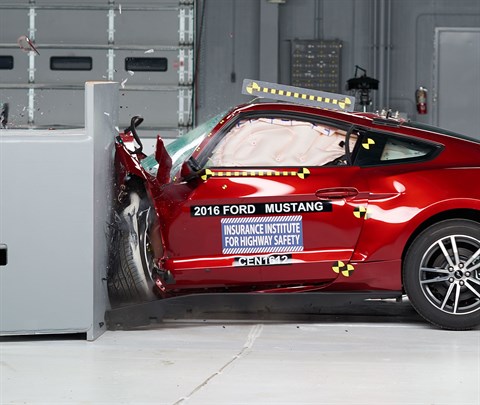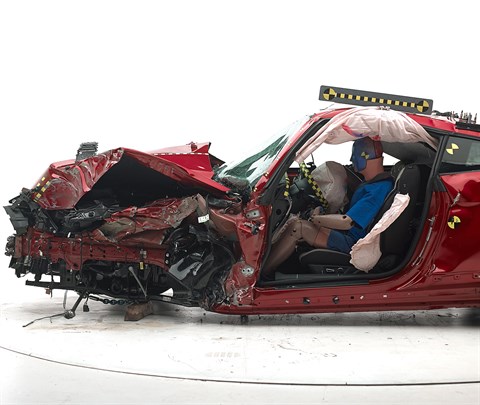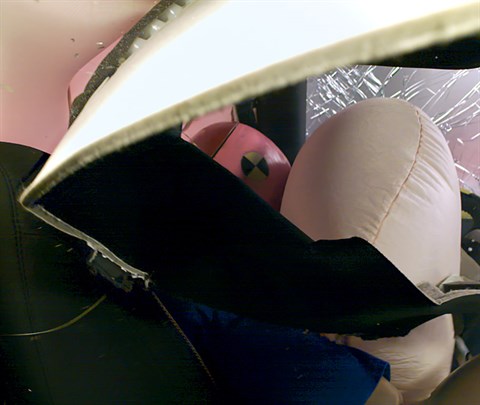Small overlap front
The small overlap front evaluation consists of a driver-side and a passenger-side component. This vehicle has an incomplete rating because it has been tested only on one side.
Driver-side
Tested vehicle: 2016 Ford Mustang GT 2-door
Rating applies to 2015-25 models
The Ford Mustang was redesigned for the 2015 model year.
| Evaluation criteria | Rating |
|---|---|
| Overall driver-side evaluation | |
| Structure and safety cage | |
| Driver injury measures | |
| Head/neck | |
| Chest | |
| Hip/thigh | |
| Lower leg/foot | |
|
Driver restraints and dummy kinematics
The dummy’s face remained in contact with the frontal airbag, but its head still rolled around the left side of the steering wheel toward the intruding A-pillar because the seat belt allowed excessive forward excursion of the head and torso. The side curtain airbag deployed and has sufficient forward coverage to protect the head from contact with side structure and outside objects. The side torso airbag also deployed. | |

Action shot taken during the small overlap frontal crash test.

The dummy's position in relation to the door frame, steering wheel, and instrument panel after the crash test indicates that the driver's survival space was not maintained well.

The dummy’s head contacted the frontal airbag but rolled around the left side, allowing the head to approach the intruding A-pillar. (The car's headliner partially blocked the view; it became loose because of camera installation on the roof but did not interfere with the dummy's motion or the side curtain airbag deployment.)

Despite considerable intrusion of the door hinge pillar and instrument panel, risk of injuries to the dummy's legs and feet was low.
Measures of occupant compartment intrusion on driver side
| Evaluation criteria | Measurement |
|---|---|
| Test ID | CEN1612 |
| Lower occupant compartment | |
| Lower hinge pillar max (cm) | 15 |
| Footrest (cm) | 17 |
| Left toepan (cm) | 12 |
| Brake pedal (cm) | 15 |
| Parking brake (cm) | |
| Rocker panel lateral average (cm) | 2 |
| Upper occupant compartment | |
| Steering column | 5 |
| Upper hinge pillar max (cm) | 14 |
| Upper dash (cm) | 16 |
| Lower instrument panel (cm) | 13 |
Driver injury measures
| Evaluation criteria | Measurement |
|---|---|
| Test ID | CEN1612 |
| Head | |
| HIC-15 | 147 |
| Peak gs at hard contact | no contact |
| Neck | |
| Tension (kN) | 1.1 |
| Extension bending moment (Nm) | 6 |
| Maximum Nij | 0.20 |
| Chest maximum compression (mm) | 25 |
| Femur (kN) | |
| Left | 2.8 |
| Right | 1.4 |
| Knee displacement (mm) | |
| Left | 4 |
| Right | 2 |
| Knee-thigh-hip injury risk (%) | |
| Left | 0 |
| Right | 0 |
| Maximum tibia index | |
| Left | 0.74 |
| Right | 0.66 |
| Tibia axial force (kN) | |
| Left | 3.3 |
| Right | 2.5 |
| Foot acceleration (g) | |
| Left | 102 |
| Right | 67 |
Child seat anchors
Rating applies to 2016-25 models
| Evaluation criteria | Rating |
|---|---|
| Overall evaluation | |
| Vehicle trim | GT |
| Seat type | cloth |
This vehicle has 2 rear seating positions with complete child seat attachment (LATCH) hardware.
| Rating icon | Rating |
|---|---|
| G | Good |
| A | Acceptable |
| M | Marginal |
| P | Poor |
| Seating positions that rely on borrowed lower anchors or have only a tether anchor available are not rated. | |
thether anchor symbol | Tether anchor |
lower anchor symbol | Lower anchors |
| Lower anchor(s) can be borrowed from adjacent positions(s) | |
| No hardware available |
Details by seating position
| Position | Rating |
|---|---|
| 1 | |
| Tether anchor | |
| easy-to-find location | |
| no other hardware could be confused for anchor | |
| Lower anchors | |
| too deep in seat | |
| too much force needed to attach | |
| easy to maneuver around anchors | |
| 3 | |
| Tether anchor | |
| easy-to-find location | |
| no other hardware could be confused for anchor | |
| Lower anchors | |
| too deep in seat | |
| too much force needed to attach | |
| easy to maneuver around anchors |
Seat position 21
| Lower anchor A | |
|---|---|
| Open access rated | No |
| Depth (cm) | 2-4 |
| Force (lbs) | 38 |
| Clearance angle (degrees) | 100 |
| Lower anchor B | |
| Open access rated | No |
| Depth (cm) | 4-6 |
| Force (lbs) | could not measure |
| Clearance angle (degrees) | 62 |
| Tether anchor | |
| Location | Rear deck |
| Confusing hardware present | No |
| Has contrasting label within 3 inches of tether anchor |
No |
| Tether anchors can be accessed while seatback is properly positioned for use of LATCH |
Not measured |
Seat position 23
| Lower anchor A | |
|---|---|
| Open access rated | No |
| Depth (cm) | 4-6 |
| Force (lbs) | could not measure |
| Clearance angle (degrees) | 71 |
| Lower anchor B | |
| Open access rated | No |
| Depth (cm) | 2-4 |
| Force (lbs) | 34 |
| Clearance angle (degrees) | 96 |
| Tether anchor | |
| Location | Rear deck |
| Confusing hardware present | No |
| Has contrasting label within 3 inches of tether anchor |
No |
| Tether anchors can be accessed while seatback is properly positioned for use of LATCH |
Not measured |
